Analysis of Under Armour Inc.'s Operational Strategy and Supply Chain
VerifiedAdded on 2022/08/09
|7
|1478
|335
Report
AI Summary
This report provides a comprehensive analysis of Under Armour, Inc.'s operational strategy and supply network. Part 1 delves into the key decision areas, focusing on how the company meets its performance objectives of quality, speed, dependability, flexibility, and cost. It examines Under Armour's focus on innovative products, consumer-centricity, data analytics, and strategic growth opportunities, including footwear, direct-to-consumer, women's, and international business. Part 2 explores Under Armour's supply network strategy, highlighting its reliance on overseas manufacturers and the flow of products. It discusses the company's strategic characteristics, including outsourcing, supply chain management, and relationships with competitors like Nike and Adidas. The report also identifies risks associated with the supply chain, such as overdependence on third-party suppliers and potential patent infringement, along with strategies to mitigate these risks. The analysis considers the company's distribution channels, strategic alliances, and overall market positioning within the global sportswear industry.
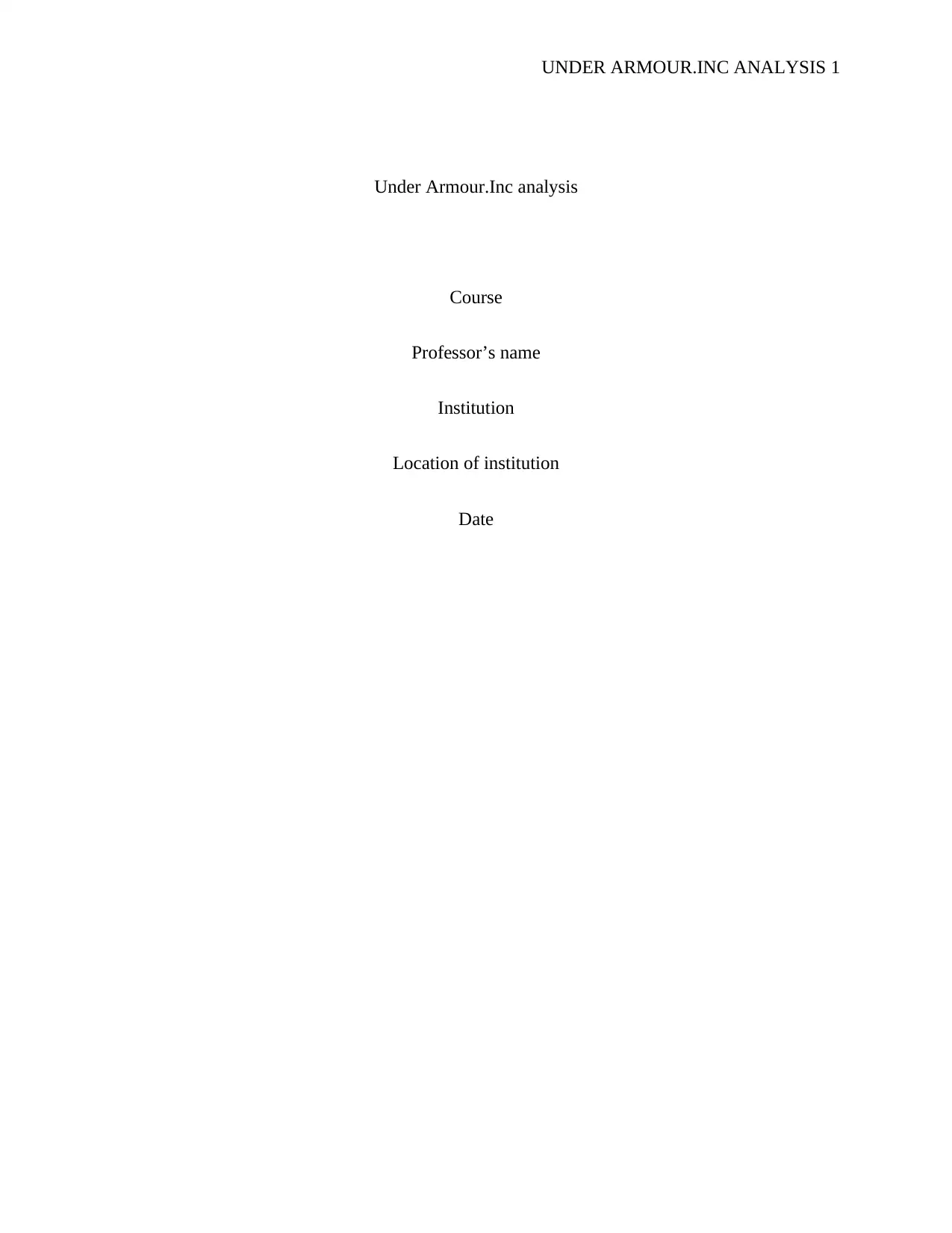
UNDER ARMOUR.INC ANALYSIS 1
Under Armour.Inc analysis
Course
Professor’s name
Institution
Location of institution
Date
Under Armour.Inc analysis
Course
Professor’s name
Institution
Location of institution
Date
Paraphrase This Document
Need a fresh take? Get an instant paraphrase of this document with our AI Paraphraser
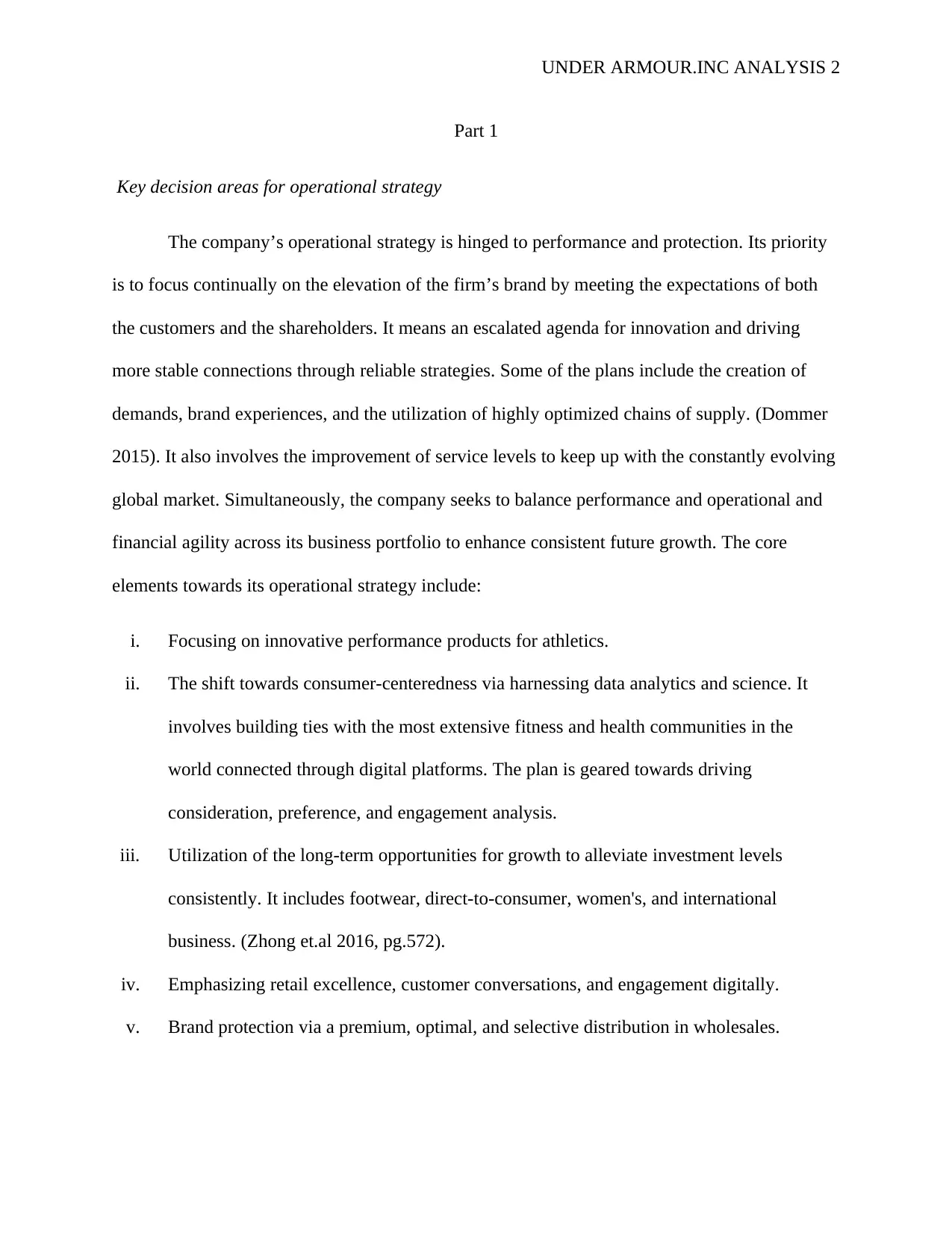
UNDER ARMOUR.INC ANALYSIS 2
Part 1
Key decision areas for operational strategy
The company’s operational strategy is hinged to performance and protection. Its priority
is to focus continually on the elevation of the firm’s brand by meeting the expectations of both
the customers and the shareholders. It means an escalated agenda for innovation and driving
more stable connections through reliable strategies. Some of the plans include the creation of
demands, brand experiences, and the utilization of highly optimized chains of supply. (Dommer
2015). It also involves the improvement of service levels to keep up with the constantly evolving
global market. Simultaneously, the company seeks to balance performance and operational and
financial agility across its business portfolio to enhance consistent future growth. The core
elements towards its operational strategy include:
i. Focusing on innovative performance products for athletics.
ii. The shift towards consumer-centeredness via harnessing data analytics and science. It
involves building ties with the most extensive fitness and health communities in the
world connected through digital platforms. The plan is geared towards driving
consideration, preference, and engagement analysis.
iii. Utilization of the long-term opportunities for growth to alleviate investment levels
consistently. It includes footwear, direct-to-consumer, women's, and international
business. (Zhong et.al 2016, pg.572).
iv. Emphasizing retail excellence, customer conversations, and engagement digitally.
v. Brand protection via a premium, optimal, and selective distribution in wholesales.
Part 1
Key decision areas for operational strategy
The company’s operational strategy is hinged to performance and protection. Its priority
is to focus continually on the elevation of the firm’s brand by meeting the expectations of both
the customers and the shareholders. It means an escalated agenda for innovation and driving
more stable connections through reliable strategies. Some of the plans include the creation of
demands, brand experiences, and the utilization of highly optimized chains of supply. (Dommer
2015). It also involves the improvement of service levels to keep up with the constantly evolving
global market. Simultaneously, the company seeks to balance performance and operational and
financial agility across its business portfolio to enhance consistent future growth. The core
elements towards its operational strategy include:
i. Focusing on innovative performance products for athletics.
ii. The shift towards consumer-centeredness via harnessing data analytics and science. It
involves building ties with the most extensive fitness and health communities in the
world connected through digital platforms. The plan is geared towards driving
consideration, preference, and engagement analysis.
iii. Utilization of the long-term opportunities for growth to alleviate investment levels
consistently. It includes footwear, direct-to-consumer, women's, and international
business. (Zhong et.al 2016, pg.572).
iv. Emphasizing retail excellence, customer conversations, and engagement digitally.
v. Brand protection via a premium, optimal, and selective distribution in wholesales.
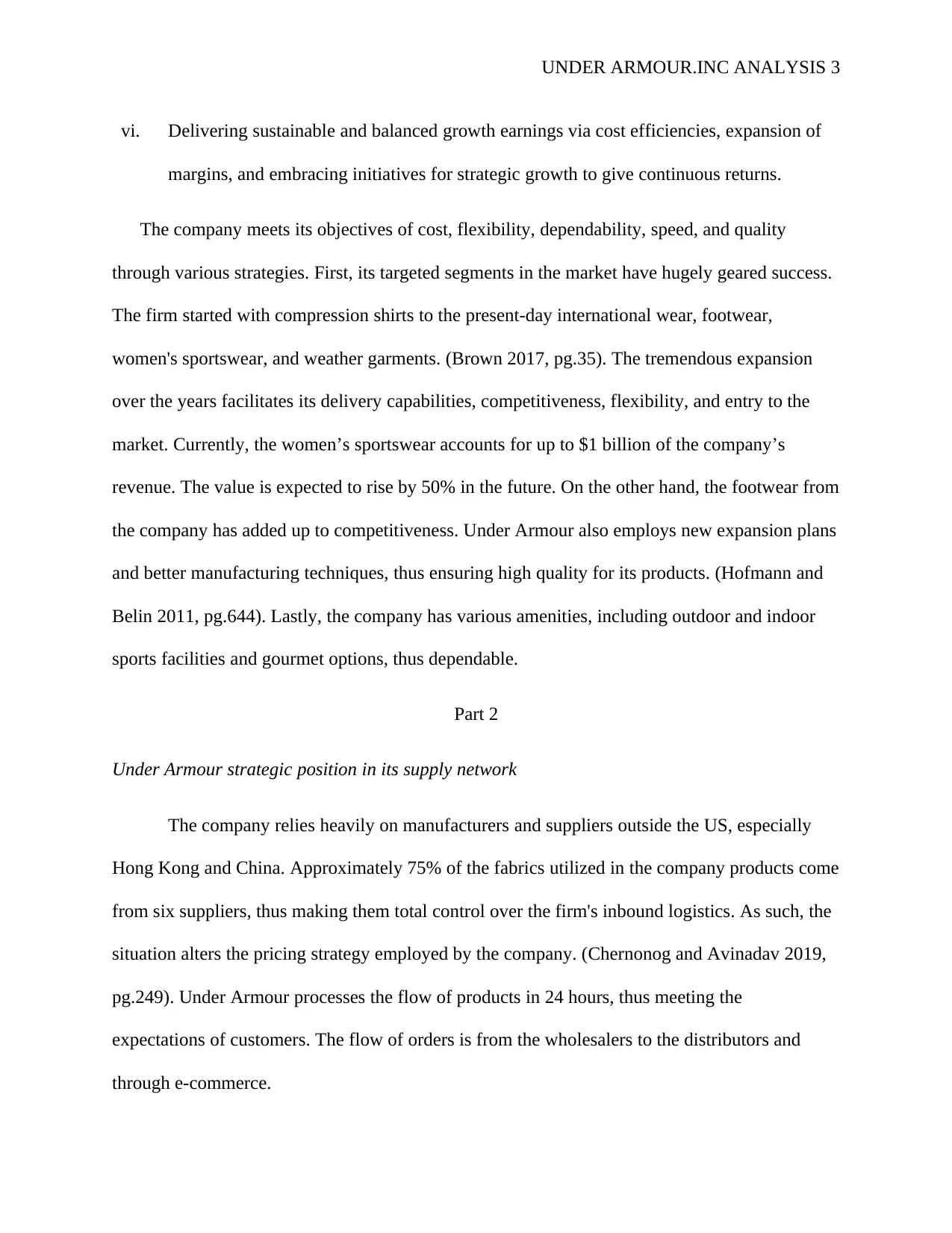
UNDER ARMOUR.INC ANALYSIS 3
vi. Delivering sustainable and balanced growth earnings via cost efficiencies, expansion of
margins, and embracing initiatives for strategic growth to give continuous returns.
The company meets its objectives of cost, flexibility, dependability, speed, and quality
through various strategies. First, its targeted segments in the market have hugely geared success.
The firm started with compression shirts to the present-day international wear, footwear,
women's sportswear, and weather garments. (Brown 2017, pg.35). The tremendous expansion
over the years facilitates its delivery capabilities, competitiveness, flexibility, and entry to the
market. Currently, the women’s sportswear accounts for up to $1 billion of the company’s
revenue. The value is expected to rise by 50% in the future. On the other hand, the footwear from
the company has added up to competitiveness. Under Armour also employs new expansion plans
and better manufacturing techniques, thus ensuring high quality for its products. (Hofmann and
Belin 2011, pg.644). Lastly, the company has various amenities, including outdoor and indoor
sports facilities and gourmet options, thus dependable.
Part 2
Under Armour strategic position in its supply network
The company relies heavily on manufacturers and suppliers outside the US, especially
Hong Kong and China. Approximately 75% of the fabrics utilized in the company products come
from six suppliers, thus making them total control over the firm's inbound logistics. As such, the
situation alters the pricing strategy employed by the company. (Chernonog and Avinadav 2019,
pg.249). Under Armour processes the flow of products in 24 hours, thus meeting the
expectations of customers. The flow of orders is from the wholesalers to the distributors and
through e-commerce.
vi. Delivering sustainable and balanced growth earnings via cost efficiencies, expansion of
margins, and embracing initiatives for strategic growth to give continuous returns.
The company meets its objectives of cost, flexibility, dependability, speed, and quality
through various strategies. First, its targeted segments in the market have hugely geared success.
The firm started with compression shirts to the present-day international wear, footwear,
women's sportswear, and weather garments. (Brown 2017, pg.35). The tremendous expansion
over the years facilitates its delivery capabilities, competitiveness, flexibility, and entry to the
market. Currently, the women’s sportswear accounts for up to $1 billion of the company’s
revenue. The value is expected to rise by 50% in the future. On the other hand, the footwear from
the company has added up to competitiveness. Under Armour also employs new expansion plans
and better manufacturing techniques, thus ensuring high quality for its products. (Hofmann and
Belin 2011, pg.644). Lastly, the company has various amenities, including outdoor and indoor
sports facilities and gourmet options, thus dependable.
Part 2
Under Armour strategic position in its supply network
The company relies heavily on manufacturers and suppliers outside the US, especially
Hong Kong and China. Approximately 75% of the fabrics utilized in the company products come
from six suppliers, thus making them total control over the firm's inbound logistics. As such, the
situation alters the pricing strategy employed by the company. (Chernonog and Avinadav 2019,
pg.249). Under Armour processes the flow of products in 24 hours, thus meeting the
expectations of customers. The flow of orders is from the wholesalers to the distributors and
through e-commerce.
⊘ This is a preview!⊘
Do you want full access?
Subscribe today to unlock all pages.

Trusted by 1+ million students worldwide
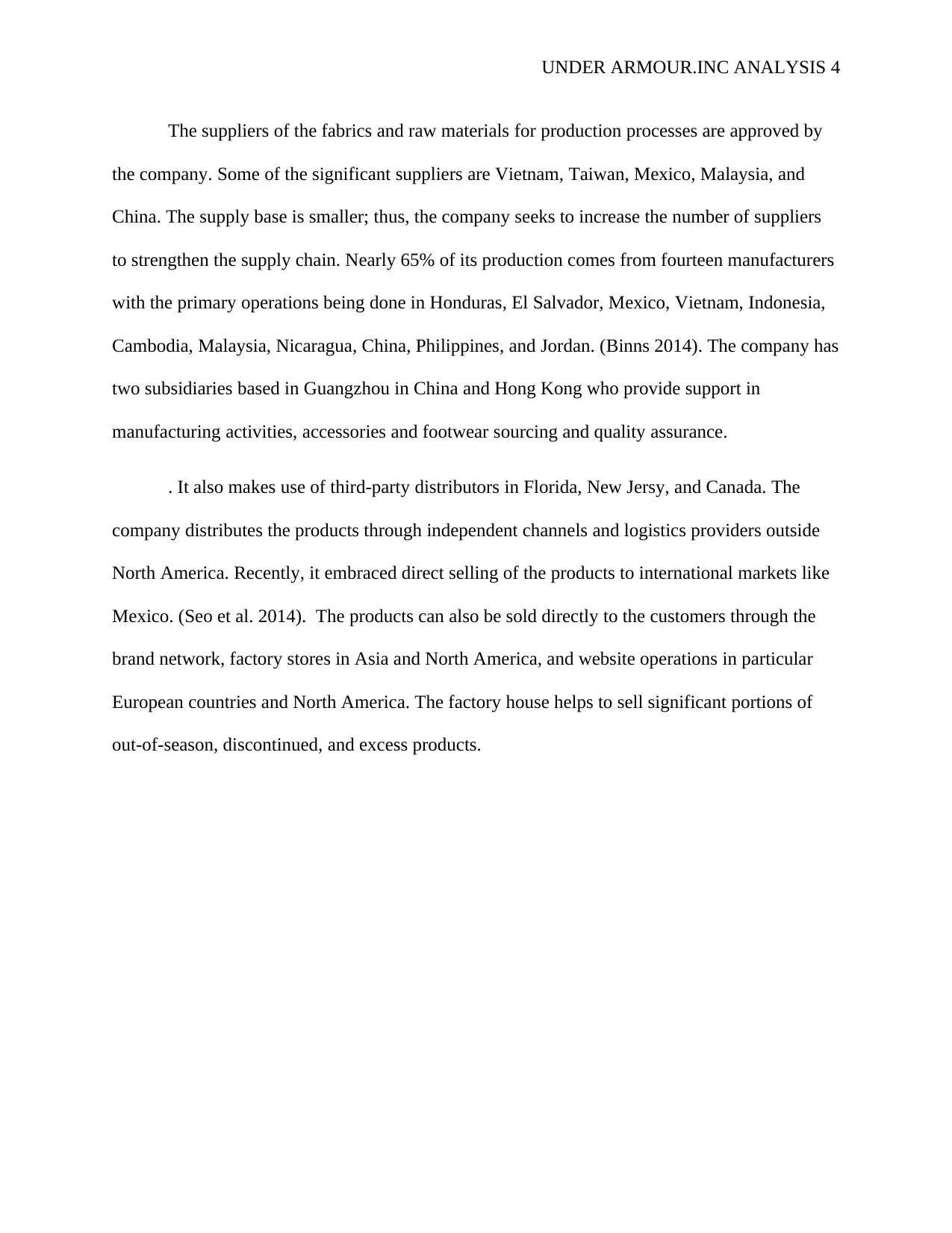
UNDER ARMOUR.INC ANALYSIS 4
The suppliers of the fabrics and raw materials for production processes are approved by
the company. Some of the significant suppliers are Vietnam, Taiwan, Mexico, Malaysia, and
China. The supply base is smaller; thus, the company seeks to increase the number of suppliers
to strengthen the supply chain. Nearly 65% of its production comes from fourteen manufacturers
with the primary operations being done in Honduras, El Salvador, Mexico, Vietnam, Indonesia,
Cambodia, Malaysia, Nicaragua, China, Philippines, and Jordan. (Binns 2014). The company has
two subsidiaries based in Guangzhou in China and Hong Kong who provide support in
manufacturing activities, accessories and footwear sourcing and quality assurance.
. It also makes use of third-party distributors in Florida, New Jersy, and Canada. The
company distributes the products through independent channels and logistics providers outside
North America. Recently, it embraced direct selling of the products to international markets like
Mexico. (Seo et al. 2014). The products can also be sold directly to the customers through the
brand network, factory stores in Asia and North America, and website operations in particular
European countries and North America. The factory house helps to sell significant portions of
out-of-season, discontinued, and excess products.
The suppliers of the fabrics and raw materials for production processes are approved by
the company. Some of the significant suppliers are Vietnam, Taiwan, Mexico, Malaysia, and
China. The supply base is smaller; thus, the company seeks to increase the number of suppliers
to strengthen the supply chain. Nearly 65% of its production comes from fourteen manufacturers
with the primary operations being done in Honduras, El Salvador, Mexico, Vietnam, Indonesia,
Cambodia, Malaysia, Nicaragua, China, Philippines, and Jordan. (Binns 2014). The company has
two subsidiaries based in Guangzhou in China and Hong Kong who provide support in
manufacturing activities, accessories and footwear sourcing and quality assurance.
. It also makes use of third-party distributors in Florida, New Jersy, and Canada. The
company distributes the products through independent channels and logistics providers outside
North America. Recently, it embraced direct selling of the products to international markets like
Mexico. (Seo et al. 2014). The products can also be sold directly to the customers through the
brand network, factory stores in Asia and North America, and website operations in particular
European countries and North America. The factory house helps to sell significant portions of
out-of-season, discontinued, and excess products.
Paraphrase This Document
Need a fresh take? Get an instant paraphrase of this document with our AI Paraphraser
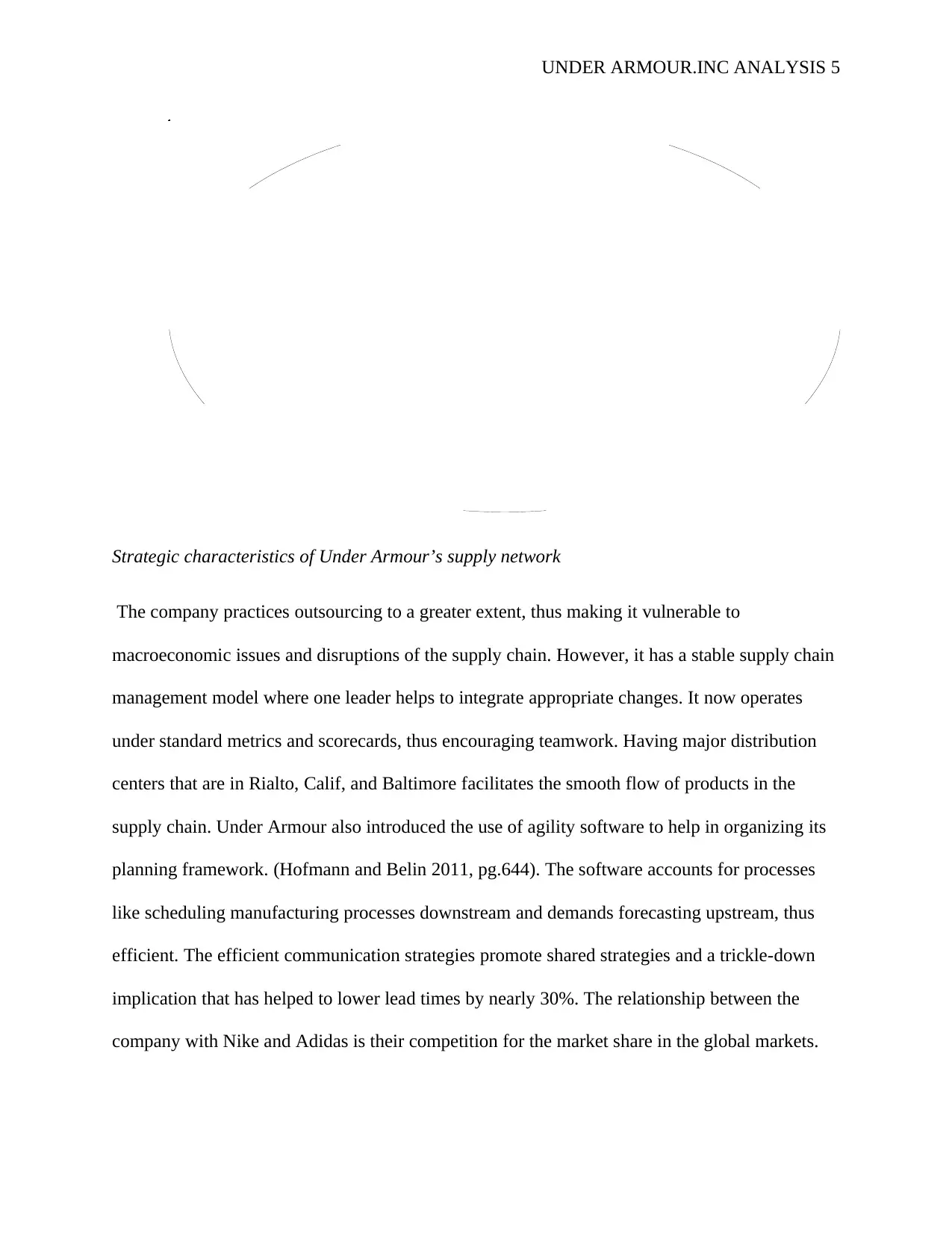
UNDER ARMOUR.INC ANALYSIS 5
Strategic characteristics of Under Armour’s supply network
The company practices outsourcing to a greater extent, thus making it vulnerable to
macroeconomic issues and disruptions of the supply chain. However, it has a stable supply chain
management model where one leader helps to integrate appropriate changes. It now operates
under standard metrics and scorecards, thus encouraging teamwork. Having major distribution
centers that are in Rialto, Calif, and Baltimore facilitates the smooth flow of products in the
supply chain. Under Armour also introduced the use of agility software to help in organizing its
planning framework. (Hofmann and Belin 2011, pg.644). The software accounts for processes
like scheduling manufacturing processes downstream and demands forecasting upstream, thus
efficient. The efficient communication strategies promote shared strategies and a trickle-down
implication that has helped to lower lead times by nearly 30%. The relationship between the
company with Nike and Adidas is their competition for the market share in the global markets.
suppliersmanufacturingdistributorsretailersconsumers
Strategic characteristics of Under Armour’s supply network
The company practices outsourcing to a greater extent, thus making it vulnerable to
macroeconomic issues and disruptions of the supply chain. However, it has a stable supply chain
management model where one leader helps to integrate appropriate changes. It now operates
under standard metrics and scorecards, thus encouraging teamwork. Having major distribution
centers that are in Rialto, Calif, and Baltimore facilitates the smooth flow of products in the
supply chain. Under Armour also introduced the use of agility software to help in organizing its
planning framework. (Hofmann and Belin 2011, pg.644). The software accounts for processes
like scheduling manufacturing processes downstream and demands forecasting upstream, thus
efficient. The efficient communication strategies promote shared strategies and a trickle-down
implication that has helped to lower lead times by nearly 30%. The relationship between the
company with Nike and Adidas is their competition for the market share in the global markets.
suppliersmanufacturingdistributorsretailersconsumers
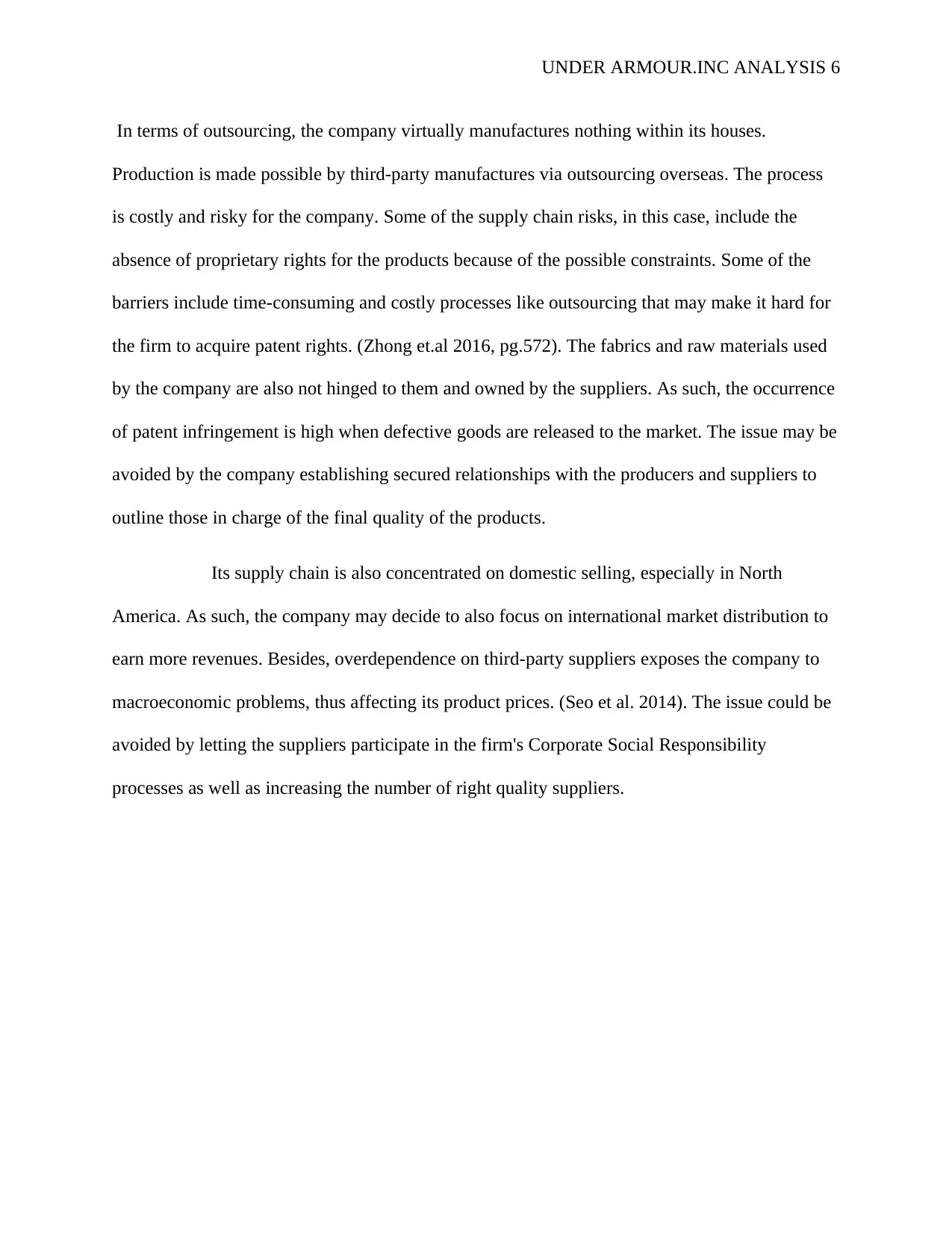
UNDER ARMOUR.INC ANALYSIS 6
In terms of outsourcing, the company virtually manufactures nothing within its houses.
Production is made possible by third-party manufactures via outsourcing overseas. The process
is costly and risky for the company. Some of the supply chain risks, in this case, include the
absence of proprietary rights for the products because of the possible constraints. Some of the
barriers include time-consuming and costly processes like outsourcing that may make it hard for
the firm to acquire patent rights. (Zhong et.al 2016, pg.572). The fabrics and raw materials used
by the company are also not hinged to them and owned by the suppliers. As such, the occurrence
of patent infringement is high when defective goods are released to the market. The issue may be
avoided by the company establishing secured relationships with the producers and suppliers to
outline those in charge of the final quality of the products.
Its supply chain is also concentrated on domestic selling, especially in North
America. As such, the company may decide to also focus on international market distribution to
earn more revenues. Besides, overdependence on third-party suppliers exposes the company to
macroeconomic problems, thus affecting its product prices. (Seo et al. 2014). The issue could be
avoided by letting the suppliers participate in the firm's Corporate Social Responsibility
processes as well as increasing the number of right quality suppliers.
In terms of outsourcing, the company virtually manufactures nothing within its houses.
Production is made possible by third-party manufactures via outsourcing overseas. The process
is costly and risky for the company. Some of the supply chain risks, in this case, include the
absence of proprietary rights for the products because of the possible constraints. Some of the
barriers include time-consuming and costly processes like outsourcing that may make it hard for
the firm to acquire patent rights. (Zhong et.al 2016, pg.572). The fabrics and raw materials used
by the company are also not hinged to them and owned by the suppliers. As such, the occurrence
of patent infringement is high when defective goods are released to the market. The issue may be
avoided by the company establishing secured relationships with the producers and suppliers to
outline those in charge of the final quality of the products.
Its supply chain is also concentrated on domestic selling, especially in North
America. As such, the company may decide to also focus on international market distribution to
earn more revenues. Besides, overdependence on third-party suppliers exposes the company to
macroeconomic problems, thus affecting its product prices. (Seo et al. 2014). The issue could be
avoided by letting the suppliers participate in the firm's Corporate Social Responsibility
processes as well as increasing the number of right quality suppliers.
⊘ This is a preview!⊘
Do you want full access?
Subscribe today to unlock all pages.

Trusted by 1+ million students worldwide
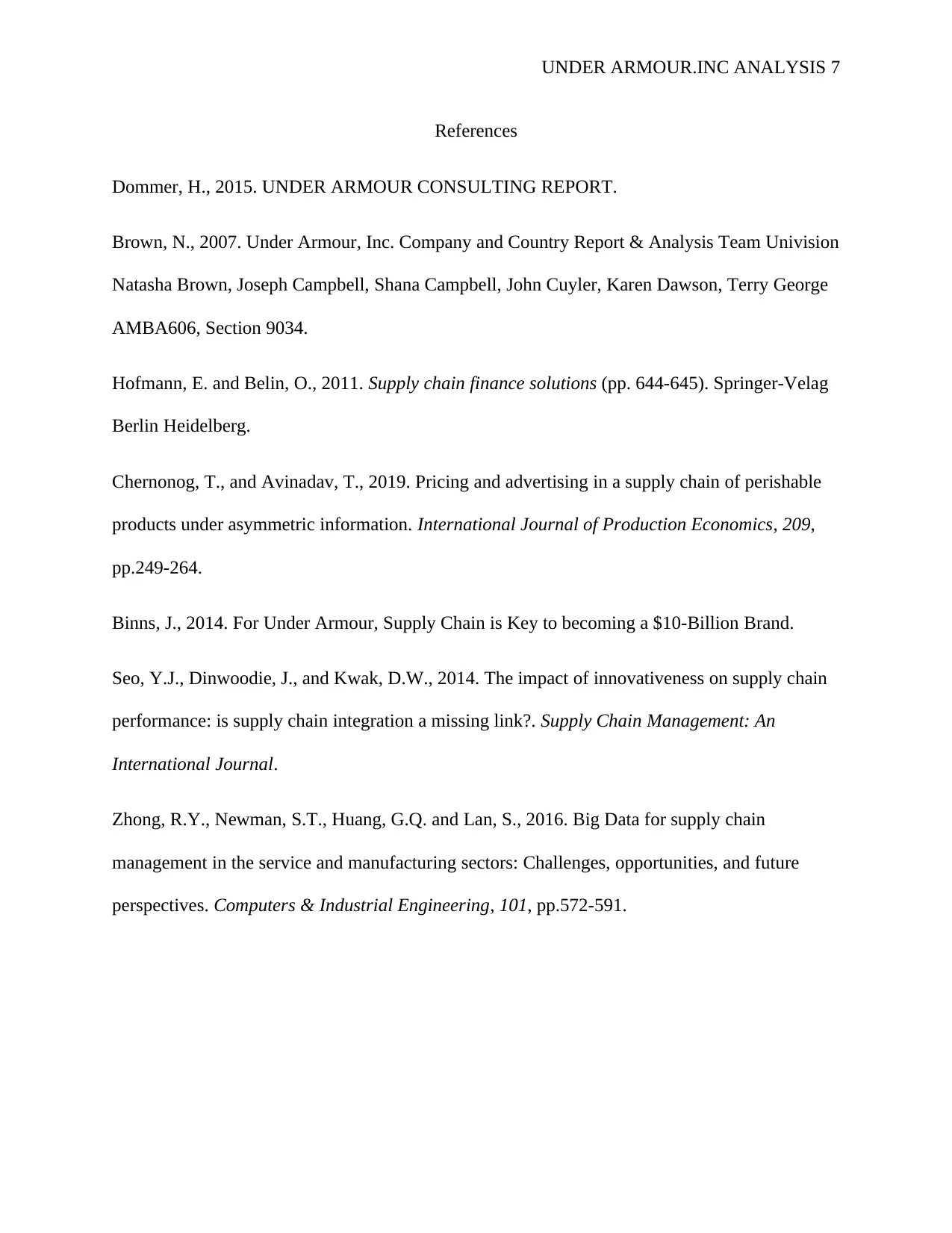
UNDER ARMOUR.INC ANALYSIS 7
References
Dommer, H., 2015. UNDER ARMOUR CONSULTING REPORT.
Brown, N., 2007. Under Armour, Inc. Company and Country Report & Analysis Team Univision
Natasha Brown, Joseph Campbell, Shana Campbell, John Cuyler, Karen Dawson, Terry George
AMBA606, Section 9034.
Hofmann, E. and Belin, O., 2011. Supply chain finance solutions (pp. 644-645). Springer-Velag
Berlin Heidelberg.
Chernonog, T., and Avinadav, T., 2019. Pricing and advertising in a supply chain of perishable
products under asymmetric information. International Journal of Production Economics, 209,
pp.249-264.
Binns, J., 2014. For Under Armour, Supply Chain is Key to becoming a $10-Billion Brand.
Seo, Y.J., Dinwoodie, J., and Kwak, D.W., 2014. The impact of innovativeness on supply chain
performance: is supply chain integration a missing link?. Supply Chain Management: An
International Journal.
Zhong, R.Y., Newman, S.T., Huang, G.Q. and Lan, S., 2016. Big Data for supply chain
management in the service and manufacturing sectors: Challenges, opportunities, and future
perspectives. Computers & Industrial Engineering, 101, pp.572-591.
References
Dommer, H., 2015. UNDER ARMOUR CONSULTING REPORT.
Brown, N., 2007. Under Armour, Inc. Company and Country Report & Analysis Team Univision
Natasha Brown, Joseph Campbell, Shana Campbell, John Cuyler, Karen Dawson, Terry George
AMBA606, Section 9034.
Hofmann, E. and Belin, O., 2011. Supply chain finance solutions (pp. 644-645). Springer-Velag
Berlin Heidelberg.
Chernonog, T., and Avinadav, T., 2019. Pricing and advertising in a supply chain of perishable
products under asymmetric information. International Journal of Production Economics, 209,
pp.249-264.
Binns, J., 2014. For Under Armour, Supply Chain is Key to becoming a $10-Billion Brand.
Seo, Y.J., Dinwoodie, J., and Kwak, D.W., 2014. The impact of innovativeness on supply chain
performance: is supply chain integration a missing link?. Supply Chain Management: An
International Journal.
Zhong, R.Y., Newman, S.T., Huang, G.Q. and Lan, S., 2016. Big Data for supply chain
management in the service and manufacturing sectors: Challenges, opportunities, and future
perspectives. Computers & Industrial Engineering, 101, pp.572-591.
1 out of 7
Related Documents
Your All-in-One AI-Powered Toolkit for Academic Success.
+13062052269
info@desklib.com
Available 24*7 on WhatsApp / Email
![[object Object]](/_next/static/media/star-bottom.7253800d.svg)
Unlock your academic potential
Copyright © 2020–2025 A2Z Services. All Rights Reserved. Developed and managed by ZUCOL.



